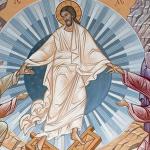G. Biguzzi asks whether the city “Babylon” (Revelation 17-18) represents Rome or Jerusalem. The first option was presented early, by Victorinus. He “(i) gives the circumlocution, ‘city of Rome,’ as toe equivalent of Babylon: . . . ruina Babylonis, id est civitatis Romanae, (ii) identifies the seven mountains of Rev 17,9, on which the Harlot is seated, with the seven hills of Rome: Capita septem [sunt] septem montes, super quos mulier sedet: id est civitas Romana, et reges septem sunt, and (iii) interprets the mortally wounded head of the Beast, as an allusion to toe legend of toe Nero restored to life (redivivus) and returning from toe East against Rome as his enemy (redux): Unum autem de capitibus quasi occisum in mortem et plagam mortis eius curatam, Neronem dicit. Constat enimy dum insequeretur eum equitatus missus a senatu ipsum sibi gulam succidisse. Hunc ergo suscitatum Deus mittet” (373).
Tyconius, followed by Augustine, shifted the majority interpretation from a specific city to the generic “city of man,” but in the Reformation era and after a new interpretation arose, linking the city with Jerusalem rather than Rome: “The first to see Jerusalem in Rev’s Babylon were the French Jesuit J. Hardouin (1646-1729) and the French Calvinist F. Abauzit (1679-1767). According to the former the seven messages of Rev 2-3 are addressed to the Jewish-Christians of Jerusalem, and according to the latter the Beast is the Jewish Sanhédrin, the seven mountains of Rev 17,9 are the seven hills on which Jerusalem stands, and the fall of Babylon is the fall of Jerusalem in 70 A.D.” (475).
This interpretation has been held by a minority of interpreters in the past century, in various forms. J. Massyngberde Ford”holds that Babylon is Jerusalem sinee it became a prostitute in its political alliance with the Romans, represented as ‘the many waters’ (the Kittim of Qumran literature) upon which the Harlot is sitting (17,1.15). The Beast from the sea is Vespasian, who ‘was’,’ when was standing high in Nero’s favour; ‘is not,’ when he loses his favour; and ‘is to come,’ when he will be sent by him to quell the Jewish revolt in A.D. 67. The Beast from the land, instead, is Flavius Josephus, since he greeted Vespasian ‘prophetically’ as the future emperor (cf. the epithet, ‘pseudo-prophet’ given to the second Beast in Rev), and because he accepted the mark and the name of the ‘Beast’ when he accepted the nomen ‘Flavius’ from the imperial family” (379).
That is awfully specific. E. Corsini’s interpretation is more general: “the Beast from the Sea is Rome and/or the Roman empire, which is a symbol of every corrupt centre if political power. The Beast from the land is Jerusalem and/or the Jewish world, which had become a ‘Synagogue of Satan.’ The two horns ٠٤ the Beast are the Law and the Prophets, interpreted in a material and mundane sense by the corrupted Jerusalem. The two powers, the political one of Rome and the religious of Jerusalem, are by now allied, and such a ‘monstrous alliance,’ according to Corsini, is paradigmatically represented in the allegory of the Harlot sitting on the Beast (Rev 17,3). Finally, the rebellion of the Beast against Babylon and the destruction of it (Rev 17,16) are the Jewish revolt and the destruction of Jerusalem by the Roman armies in the years 66-70 A.D., when the two allies separate and then clash in a mortal duel” (379).
Biguzzi opts for the Roman interpretation, but he presents a fair review of the evidence and options.
(Biguzzi, “Is the Babylon of Revelation Rome or Jerusalem?” Biblica 28 [2006]: 371-86.)














